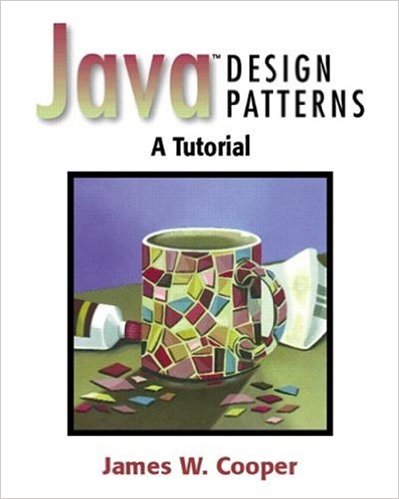
The Design Patterns: Java Companion
A catalog of 23 generally useful patterns for writing object-oriented software, each of them is presented with at least one complete, visual Java program.
Tag(s): Java
Publication date: 13 Feb 2000
ISBN-10: 0201485397
ISBN-13: 9780201485394
Paperback: 352 pages
Views: 35,248
The Design Patterns: Java Companion
 A catalog of 23 generally useful patterns for writing object-oriented software, each of them is presented with at least one complete, visual Java program.
A catalog of 23 generally useful patterns for writing object-oriented software, each of them is presented with at least one complete, visual Java program.
Tag(s):
Java
Publication date: 13 Feb 2000
ISBN-10: 0201485397
ISBN-13: 9780201485394
Paperback: 352 pages
Views: 35,248
Document Type: N/A
Publisher: Addison-Wesley Professional
License: n/a
Post time: 28 Oct 2004 11:54:33
Publication date: 13 Feb 2000
ISBN-10: 0201485397
ISBN-13: 9780201485394
Paperback: 352 pages
Views: 35,248
Document Type: N/A
Publisher: Addison-Wesley Professional
License: n/a
Post time: 28 Oct 2004 11:54:33
Book excerpts:
It could be somewhat off-putting, but design patterns are just convenient ways of reusing object-oriented code between projects and between programmers. The idea behind design patterns is simple -- write down and catalog common interactions between objects that programmers have frequently found useful.
Design Patterns is a catalog of 23 generally useful patterns for writing object-oriented software. It is written as a catalog with short examples and substantial discussions of how the patterns can be constructed and applied. Each of the 23 patterns is presented with at least one complete, visual Java program.
Nearly all of the example programs in this book use the JFC to produce the interfaces the example code. Since not everyone may be familiar with these classes, and since the the intend is to build some basic classes from the JFC to use throughout the examples, there will be a short break after introducing the creational patterns and the readers will spend a chapter introducing the JFC. While the chapter is not a complete tutorial in every aspect of the JFC, it does introduce the most useful interface controls and shows how to use them.
It could be somewhat off-putting, but design patterns are just convenient ways of reusing object-oriented code between projects and between programmers. The idea behind design patterns is simple -- write down and catalog common interactions between objects that programmers have frequently found useful.
Design Patterns is a catalog of 23 generally useful patterns for writing object-oriented software. It is written as a catalog with short examples and substantial discussions of how the patterns can be constructed and applied. Each of the 23 patterns is presented with at least one complete, visual Java program.
Nearly all of the example programs in this book use the JFC to produce the interfaces the example code. Since not everyone may be familiar with these classes, and since the the intend is to build some basic classes from the JFC to use throughout the examples, there will be a short break after introducing the creational patterns and the readers will spend a chapter introducing the JFC. While the chapter is not a complete tutorial in every aspect of the JFC, it does introduce the most useful interface controls and shows how to use them.
Tweet
About The Author(s)
James W. Cooper was a chemistry professor at Tufts University, and spent 25 years in IBM's Research Division, and 3 years as a Vice President of Bruker Instruments. He holds a Ph.D. in organic chemistry from Ohio State University and an A.B. from Oberlin College.
Book Categories
Computer Science
Introduction to Computer Science
Introduction to Computer Programming
Algorithms and Data Structures
Artificial Intelligence
Computer Vision
Machine Learning
Neural Networks
Game Development and Multimedia
Data Communication and Networks
Coding Theory
Computer Security
Information Security
Cryptography
Information Theory
Computer Organization and Architecture
Operating Systems
Image Processing
Parallel Computing
Concurrent Programming
Relational Database
Document-oriented Database
Data Mining
Big Data
Data Science
Digital Libraries
Compiler Design and Construction
Functional Programming
Logic Programming
Object Oriented Programming
Formal Methods
Software Engineering
Agile Software Development
Information Systems
Geographic Information System (GIS)
Mathematics
Mathematics
Algebra
Abstract Algebra
Linear Algebra
Number Theory
Numerical Methods
Precalculus
Calculus
Differential Equations
Category Theory
Proofs
Discrete Mathematics
Theory of Computation
Graph Theory
Real Analysis
Complex Analysis
Probability
Statistics
Game Theory
Queueing Theory
Operations Research
Computer Aided Mathematics
Supporting Fields
Web Design and Development
Mobile App Design and Development
System Administration
Cloud Computing
Electric Circuits
Embedded System
Signal Processing
Integration and Automation
Network Science
Project Management
Operating System
Programming/Scripting
Ada
Assembly
C / C++
Common Lisp
Forth
Java
JavaScript
Lua
Rexx
Microsoft .NET
Perl
PHP
R
Python
Rebol
Ruby
Scheme
Tcl/Tk
Miscellaneous
Sponsors
